May 2009
Monthly Archive
Sat 23 May 2009
A 1001 MIDNIGHTS Review
by Newell Dunlap:
ROSS THOMAS – The Cold War Swap. William Morrow, 1966. Paperback reprints include: Avon, 1967; Pocket, 1976; Perennial Library, 1984,1986; Mysterious Press, 1992.
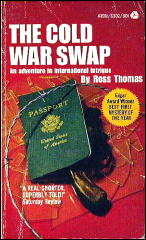
Mac’s Place is a bar located in Bonn, West Germany. It is run by McCorkle and Padillo, two expatriate Americans. The only trouble is that Padillo, from time to time, has to assume his other role as an undercover agent, take a leave of absence from the bar business, and travel to some country or another on some mission or another. Padilla never tells McCorkle where he’s going or what he’s up to, and that’s the way they both want it.
However, in this story, that arrangement begins to come unraveled. Padillo is off on another trip (nothing new there), but just as he is leaving, there is a killing in the bar that seems somehow related to his departure. And just as the furor over the killing is beginning to die down, there is an urgent message for McCorkle — a message from Padilla, trapped in East Germany and asking for Mac’s help.
This is the first of several fine international adventure/ espionage novels from Ross Thomas, and with each successive book he has established himself more and more firmly as a master of the genre. His stories, moving at a fast and intricate pace, are peopled with an amazing array — some critics might say an almost distracting array — of characters.
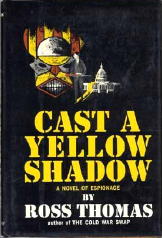
A typical Thomas protagonist is seldom young; rather, he is flirting with middle age, is a little world-weary but still able to take care of himself, and should know better than to get involved in the situation that confronts him. But, for personal and/or professional reasons, he does become involved.
And indeed, McCorkle does become involved. He travels to East Germany to be met by betrayal, a certain amount of failure, and a certain amount of success. The scenes that take place during his stay behind the Iron Curtain are especially palpable and nerve-racking.
Other novels featuring McCorkle and Padillo are Cast a Yellow Shadow (1967) and The Backup Man (1971).
———
Reprinted with permission from 1001 Midnights, edited by Bill Pronzini & Marcia Muller and published by The Battered Silicon Dispatch Box, 2007. Copyright © 1986, 2007 by the Pronzini-Muller Family Trust.
Sat 23 May 2009
Posted by Steve under
ReviewsNo Comments
IT’S ABOUT CRIME
by Marvin Lachman
ROSS THOMAS – The Cold War Swap. William Morrow, 1966. Paperback reprints include: Avon, 1967; Pocket, 1976; Perennial Library, 1984,1986; Mysterious Press, 1992.
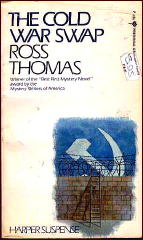
Awed by the reputation of its author and his Edgar-winning first novel, I have made three attempts to get through Ross Thomas’s The Cold War Swap. The third, and most recent, try, in a reprint from Perennial Library, was not the charm, and I gave up at page seventy.
This spy story, set on both sides of Germany’s wall, shows patches of good writing but is basically contrived with cynical, uninteresting characters caught in the usual web of international treachery.
Seemingly to pad the book, Thomas has his characters consume an incredible amount of alcohol. If it were possible to get cirrhosis from reading a book, I would now have liver disease. Instead, I merely acquired a case of acute boredom.
– From The MYSTERY FANcier, Vol. 10, No. 3, Summer 1988.
[UPDATE] 05-23-09. I asked Marv if by chance he’d had a change of heart about his review of The Cold War Swap since he wrote the review above. It’s over 20 years old, after all. His reply was, “No change in my opinion of that book. Three times is enough, so go ahead and print what I wrote.”
I’ll be pairing Marv’s comments off with the review that appeared in 1001 Midnights. It will be coming up next, or it will very soon. Look for it in another five to ten minutes.
Fri 22 May 2009
Posted by Steve under
Reviews[7] Comments
A REVIEW BY DAN STUMPF:
ALEXANDRE DUMAS, père – Joseph Balsamo. (Mémoires d’un médecin: Joseph Balsamo, 1846–1848, a.k.a. Memoirs of a Physician, Cagliostro, Madame Dubarry, The Countess Dubarry, or The Elixir of Life.)
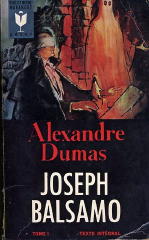
By the way, Small’s movie (Black Magic, in the previous post) opens with a framing sequence of Dumas père (Barry Kroeger) kvetching to Dumas fils (Raymond Burr!) about how hard it is to write a book about Cagliostro and the Queen’s Necklace. Well, it just so happened I had that book on my TBR shelf, so I took it down and read Dumas’s 1843 thriller Joseph Balsamo.
It’s quite good, actually, Better, I think, than the ballyhooed The Last Cavalier. Balsamo creates up an intriguing cast of characters — most of them figures from history — sets them at odds against each other, then lets them develop real personalities.
The result is pleasant melodrama and fascinating history. There’s an extended sub-plot-line of Madame DuBarry getting herself formally presented at court over the objections of Marie Antoinette that I found more exciting than any of the sword-fights and tiger hunts in Cavalier. And Dumas’ portrait of Louis XV (That “martyr to boredom” whose dimness and self-absorption were equaled in modern times only by George W. Bush) is humorous, unflinching, and oddly engaging.
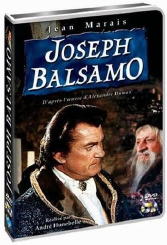
Unfortunately, as I got further and further into the 575 pages that make up this tome, I began to realize not much was happening with Cagliostro and the Queen’s Necklace. And as I got towards the end, I found Joseph Balsamo was only one of four hefty volumes Dumas spent spinning out this tale.
Damn.
I’ve said it before: when I read a book, I want to read a book; not make a down-payment on a mortgage. So you can well imagine my disappointment. Still, the writing here was good enough, the characters real enough, that I might try another installment….
Fri 22 May 2009
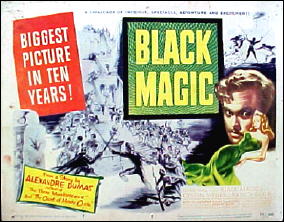
A MOVIE REVIEW BY DAN STUMPF:
BLACK MAGIC. Edward Small Productions/United Artists, 1949. Orson Welles, Nancy Guild, Akim Tamiroff, Frank Latimore, Valentina Cortese, Margot Grahame, Berry Kroeger, Raymond Burr. Based on the novel by Alexandre Dumas père. Director: Gregory Ratoff.
Call me nostalgic to the point of narcissism, but I enjoy revisiting from time to time the things that thrilled me as a kid, and at the tender age of Fourteen or so, I was convinced that Black Magic was the greatest film ever made.

Well, the intervening forty-four years have dimmed its splendor somewhat, but This is still an enjoyably campy comic book of a movie, purportedly based on Alexandre Dumas’ tale of Cagliostro (Orson Welles) and the affair of the Queen’s necklace.
The script is corny, Welles is hammy, and the direction (There are the usual rumors that Welles himself took a hand) over-emphatic, but it’s still fun, with swordfights, gypsy curses, hypnotic spells and lord-knows-what-all jamming its brief running time.
Producer Edward Small made an industry (Not a cottage industry; a real celluloid-and-press-book industry) out of adapting Dumas, whose works were in public domain, on the screen (with varying degrees of faithfulness) a passion that started with The Count of Monte Cristo in 1934, right up to Black Magic in ’49, with a stop along the way for James Whale’s The Man in the Iron Mask.
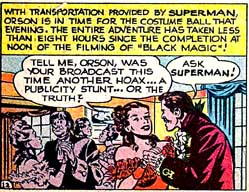
Small moved on to other projects, such as Witness for the Prosecution and It! The Terror from Beyond Space, until he at last turned to popcorn fantasy and finished his career with The Wicked Dreams of Paula Schultz, which at last gave us Elke Sommer naked.
For Black Magic, he seems to have stuffed ten pounds of Publicity into a Five-Pound-Bag, with outlandish posters, breathless trailers and even a tie-in with Superman comics, a feat of dubious artistry maybe, but executed with a modicum of wit.
Thu 21 May 2009
BURN NOTICE. Pilot episode for the USA cable network series of the same name; first telecast on 28 June 2007. Jeffrey Donovan, Gabrielle Anwar, Bruce Campbell, Sharon Gless, with David Zayas, Ray Wise, Dan Martin, China Chow, Chance Kelly.
![BURN NOTICE [USA]](https://mysteryfile.com/blogImg509/BN-Four.jpg)
Since the third season of this series will soon be beginning, you aren’t likely to need this review of the pilot episode to tell you whether or not you should be watching it. But if you’re a fan of humorous spy comedies, with a bit of Private Eye work thrown in, and if you were to ask me, I’d have to say I think you should.
If I weren’t being a bit hypocritical about it, that is, because I watched this first episode when it first was shown and never watched another one. I recently bought the DVD set of the first season, though, so there you go. Commercials and I have given up on each other. I don’t watch them, and they don’t care.
But just in case you’ve never seen (or heard) of the series, here’s a quick recap. Michael Westen (Jeffrey Donovan, whom I’ve never seen anywhere else, but he’s been around) is either a CIA agent or an independent operative who works with the CIA is abruptly — and I mean abruptly — issued a burn notice; that is to say, he’s out of a job for no stated reason, his friends won’t talk to him, his financial assets are frozen, and he’s dumped in Miami where he’s allowed to roam freely, but he’s followed and watched constantly, and he’s unable to leave.
![BURN NOTICE [USA]](https://mysteryfile.com/blogImg509/BN-Pair.jpg)
That’s the overall picture. Figuring out who’s behind it and why he’s in this fix, that’s the story that’s the basis for the series. In the meantime, to make a living, he’s forced to work as a strictly unofficial private eye, assisted by his ex-girl friend Fiona Glenanne (the diminutive but utterly glamorous Gabrielle Anwar), sporting a wonderful Irish accent, and a pensioned-off rogue of a buddy named Sam Axe (Bruce Campbell, who’s really been around).
Westen’s exasperation with his situation is played as much for laughs as it is for a story line, and I haven’t even mentioned the funniest part. Miami is where his mother lives (Sharon Gless) who wonders if this is the year her son will be home for Christmas, among other worries that a mother always has, even if her son works for the CIA.
Says Westen in voiceover mode: “Thirty years of karate, combat experience on five continents, a rating with every weapon that shoots a bullet or holds an edge… still haven’t found any defense against Mom crying into my shirt.”
In this, the pilot episode, Westen agrees to help a Cuban groundskeeper who’s suspected of stealing several valuable works of art from the home of the wealthy collector he works for, along with getting his life sorted out and set up for the rest of the series. A simple but effective story.
![BURN NOTICE [USA]](https://mysteryfile.com/blogImg509/BN-GA.jpg)
I could do without the mother, and I would have liked to have seen more of the ex-girl friend, who thinks violence is a form of foreplay, but she’s in all the ads for the show, so I assume her part is a major one. Westen himself is a little too smug for my tastes, but maybe not yours. It’s a good show, and if it weren’t for the commercials, I would have told you so long before now.
Says Westen, channeling a chap named MacGyver in a similar vein: “Once somebody sends a guy with a gun after you, things are only going to get worse. But like it or not, you’ve got work to do. For a job like getting rid of the drug dealer next door, I’ll take a hardware store over a gun any day.
“Guns make you stupid. Better to fight your wars with duct tape. Duct tape makes you smart… Every decent punk has a bulletproof door. But people forget walls are just plaster. Hopefully you get him with the first shot. Or the second… Now he’s down and waiting for you to come through the front door. So you don’t come through the front door.”
Thu 21 May 2009
A 1001 MIDNIGHTS Review
by Max Allan Collins:
MIKE ROSCOE – One Tear for My Grave.
Crown, hardcover, 1955. Paperback reprints: Signet #1358, November 1956, cover: Robert Maguire; G2432, 1964.
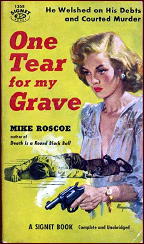
Mike Roscoe’s tough Kansas City private eye Johnny April appeared in five novels between 1951 and 1958. Although the first four went through various printings and editions, neither Roscoe nor April is much remembered today.
Both are due for revival and reassessment, as the handful of Johnny April stories are among the best produced in the wave of hard-hitting PI fiction that followed the big splash made by Mickey Spillane’s Mike Hammer.
One Tear for my Grave finds April in the presence of millionaire Avery J. Castleman and a corpse. This prologue (“The 23rd Hour”) is followed by a flashback (“The First 22 Hours”) that comprises the bulk of the book.
The lure of a fat retainer coaxes April out of bed at two in the morning to aid bookie Eddie Norris and his moll, Nicky, who have a corpse on their hands — or, actually, in their back seat. Norris claims innocence — somebody dumped this stiff in his car, says the bookie. From the cops April learns the corpse is a society type named David Matthews.
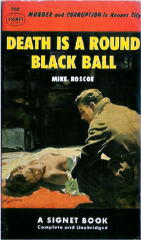
Over the coming hours, various bookies — all of them owed money by Matthews — begin to die, and not of natural causes. Among them is Norris. April bumps heads with one particularly nasty bookie named Carbone, who trashes April’s office to convince him to “lay off” this case, which only serves to enrage the detective.
April then meets with Ginny Castleman, the delicate, sympathy-arousing society girl engaged to the late Matthews; he also meets her mysterious Oriental servant, whose quiet concern for his mistress seems strangely obsessive. While bobbing and weaving between bookies and their thugs, April encounters Carbone’s moll, Lola, and a love/hate relationship blossoms.
Eventually he finds that Matthews had paid off all the bookies before their deaths; and at the Castleman mansion, April has a final confrontation with Carbone as the convoluted, ultimately tragic mystery unravels. An epilogue (“The 24th Hour”) brings the book full circle.
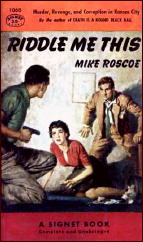
What sets such Roscoe mysteries as One Tear for My Grave apart from the crowd of would-be Spillanes is a studiously spare style. The novel is stripped for speed, consisting mostly of crisp dialogue and one- and two-sentence paragraphs.
Despite this, the language is often vivid and evocative; witness the four opening lines (and four opening paragraphs) of the novel:
There are two times when a man will lie very still.
When he is finished making love with a woman.
When he is finished with life.
The man on the floor lay still with death.
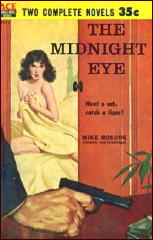
Roscoe was two men — Michael Ruso and John Roscoe — who were real private eyes, employed by Hargrave’s Detective Agency in Kansas City.
The team’s first three books — Death Is a Round Black Ball (1952), Riddle Me This (1953), and Slice of Hell (1954) — are also excellent.
The last Johnny April novel, The Midnight Eye, did not appear till 1958, half an Ace Double. While some of the poetic touches were still present, this marked a dropping off in quality over the first four, and a near absence of the dialogue/short paragraph approach.
Perhaps the team had broken up and only one of them recorded this last Johnny April case.
———
Reprinted with permission from 1001 Midnights, edited by Bill Pronzini & Marcia Muller and published by The Battered Silicon Dispatch Box, 2007. Copyright © 1986, 2007 by the Pronzini-Muller Family Trust.
Wed 20 May 2009
A REVIEW BY DAN STUMPF:
MIKE ROSCOE – One Tear for My Grave. Crown, hardcover, 1955. Paperback reprints: Signet #1358, November 1956, cover: Robert Maguire; G2432, 1964.

Call me a jaded old cynic, but when I saw the name “Mike Roscoe” on the cover of One Tear for My Grave, I somehow doubted that was the appellation his parents bestowed upon him at birth.
In fact, a little digging in Twentieth-Century Crime and Mystery Writers and on the ?net revealed this was a joint pen name for two writers, both allegedly Private Detectives, who spun a half-dozen books in the mid-50s around the exploits of PI Johnny April.
And they did rather a nice job, ladling out tough, bright, Chandler-esque prose, with a generous hand, lively and entertaining, with vivid action:
My right arm came back and connected with his gun hand. The .38 sailed across the room and banged against the wall. I saw the fist coming like a streak and heading for my belly. I tried to flex my stomach muscles.
It helped.
The punch only doubled me up half-way. I rolled to one side and sneaked a short right in. He was too quick. The damn punch just grazed him…
Extravagant description:
The rug gave under our feet with that plushy Persian feeling. It probably couldn’t have been more expensive if it had been made of live Persians.
And the improbably-cantilevered women of a young man’s dreams:
Whoever built this broad hadn’t spared the bricks.
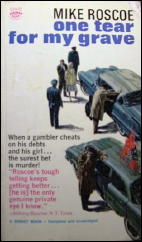
Prose like this can carry a book a long way, and for most of its brief length, Tear is a highly satisfying read, with a new twist wrinkling the end of each chapter, and a fresh corpse approximately twice a page.
But then there’s the ending, and here I must carp: It’s just plain-damn sloppy. If a crime writer centers his book around Who-killed-so-and-so, that becomes a sort of important issue in the narrative. So when the cops tell our hero that all the major suspects have alibis, we readers should either take that as a given, or get to see the PI break down whatever alibis must needs get broken.
Not here. I can say without revealing anything important that although the killer is given a clean bill early on, s/he turns out to be the killer with nary a word of explanation.
It just ain’t fair.
Fortunately, this unsatisfactory ending comes fairly late in the book, and doesn’t spoil what is for the most part, a lot of good fun. I’ll be looking for more “Mike Roscoe” and I recommend this one to anyone who likes a bright, fast-moving hard-boiled mystery.
Bibliographic data: [expanded from the Revised Crime Fiction IV, by Allen J. Hubin]
ROSCOE, MIKE. Pseudonym of John Roscoe & Michael Ruso. SC: PI Johnny April, in all.
Death Is a Round Black Ball. Crown, hc, 1952. Signet 966, pb, Oct 1952.
Riddle Me This. Crown, hc, 1952. Signet 1060, pb, Sept 1953.
Slice of Hell. Crown, hc, 1954. Signet 1216, pb, July 1955.
One Tear for My Grave. Crown, hc, 1955. Signet 1358, pb, Nov 1956.
The Midnight Eye. Ace Double D273, pbo, 1958.
Tue 19 May 2009
THE LAST DETECTIVE. Pilot episode for the British ITV series of the same name; first telecast on 7 February 2003. Peter Davison, Sean Hughes, Rob Spendlove, Emma Amos, with Joanne Frogatt, David Troughton, Rachel Davies. Based on the book Dangerous Davies: The Last Detective by Leslie Thomas. Director: Nick Hurran.
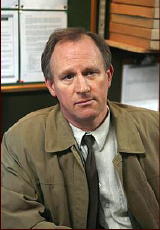
As far as the literary world is concerned, there are only four books in the “Dangerous Davies” series, but there were 17 episodes of this television series, spread out over four seasons, all part of the box set of DVDs I recently purchased, and I’m glad I did.
This, the first episode, was adapted into a TV movie once before, a production with the same title as the book, Dangerous Davies: The Last Detective (1981), written and directed by Val Guest and starring Bernard Cribbens as Davies. I’ve not seen it, but it is included in the box set. (A sad note about the earlier movie is that it marked the last screen appearance of Bernard Lee, long-time “M” of the James Bond series.)
So far as I know, Dangerous Davies never has had a first name, and the reason he is called “Dangerous” is that as a policeman, he isn’t. He’s slow, he’s methodical, the punks in the suburban town outside (or just inside) London don’t mind being arrested by him — he doesn’t resort to violence or racial epithets as the other coppers do — and he’s called the last detective, as he’d be the last one in the station house to be given a case of any significance.

It’s not really clear how he fell so far in the opinions of his fellow officers or Inspector Aspinall (Rod Spendlove), his superior officer, as there are no flashbacks to tell the viewer (the writers of the TV series may want to hold that back for a while) and of all of the accents of the players involved, it’s those of his fellow policemen which I found the most difficult to translate.
Davies, as I see I haven’t mentioned it so far, is played by Peter Davison — or should I say underplayed, as he’s certainly the gentlest and most patient of police detectives I have ever seen on TV. (This may be why he gets on the nerves of his fellow officers.) Davison, of course, also played Dr. Who for a while in his long acting career, as well as a shorter stint as Albert Campion, Margery Allingham’s stalwart but enigmatic hero.

Assigned a nothing job to see whether a known hoodlum is coming back to England from Spain, and if so, why, Davies sidetracks himself onto another case, one that been open and unsolved for 20 years — that of a 17-year-old girl who went missing one night, her body never found.
Reopening the case means wounding the girl’s family all over again, her mother, her father, and especially the girl’s sister, who came along only after her older sibling disappeared. Joanne Frogatt plays both parts, Josie in the present, and Celia in the past.
She’s cheeky, sexy and vulnerable at the same time, and as Josie, at point slyly (but almost shyly) makes a play for Davies. It’s a wonderful performance.
Davies, though, is married, but only barely. Emma Amos plays his wife, exasperated by Davies, unable to live with him, but there’s a sense that she still loves him, and if so, I imagine this is a thread that will play its way out over the course of the series. (They do have a large dog in common.)
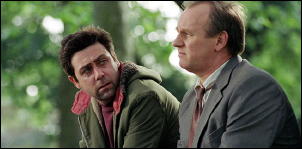
Stand-up comedian Sean Hughes plays Davies’ buddy Mod, who assists him on his cases, very much unofficially, while holding a number of real jobs, including dog-walker and door-to-door interviewer about the sex lives of senior citizens — and not very successfully.
The ending is bittersweet, as Davies’ approach, low key but effective at the same time, is to persuade the killer to confess. Thus justice is done, but with no fanfare and at the same time embarrassing the department — slipshod and ineffective policework was done at the time — and thus getting himself into a deeper hole on the job.
Episode Two now awaits me. While I’m not likely to be reporting on more, I am more than ready for the task. Eager, in fact. After a while, watching endless car chases on The Rockford Files eventually become boring, no matter how much you enjoy James Garner as Rockford.
Tue 19 May 2009
Posted by Steve under
ReviewsNo Comments
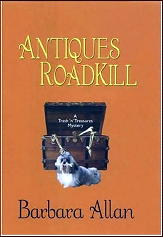
REVIEWED BY WALTER ALBERT:
BARBARA ALLAN – Antiques Roadkill. “A Trash ‘n’ Treasures Mystery.” Kensington Books, hardcover, August 2006. Paperback reprint: July 2007.
JANE K. CLELAND – Consigned to Death. St. Martin’s, hardcover, April 2006. Paperback reprint: April 2007.
I was bored with the pseudonymous Barbara Allan novel, apparently produced by the husband-and-wife team of Max Allan and Barbara Collins. The characters were pasteboard and the plot was so vaporous that even reading the copy on the back jacket didn’t bring any of it back to me. But what do I know?
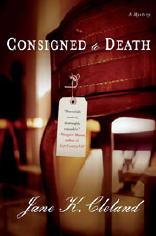 Consigned to Death, Cleland’s debut for antiques dealer Josie Prescott.
Consigned to Death, Cleland’s debut for antiques dealer Josie Prescott.
Cleland has a background in both antiques and rare books, and her New Hampshire coastal setting, with well-drawn characters and an intriguing mystery plot, have me looking forward to a second outing, Deadly Appraisal, previewed in a supplement to Consigned.
Tue 19 May 2009
H. J. S. Anderton is hardly an author who is or ever was a household name, but Steve Holland recently posted the results of his research into his life on his Bear Alley blog.
A British writer, Anderton was responsible for nine crime thrillers that came out in the 1930s. The titles are included in the Revised Crime Fiction IV, by Allen J. Hubin, all published in cheap paperback form, but what Steve has come up with for the first time is his full name, the year he was born, when he died, and most amazingly, some information about his family.
Anderton’s books are impossibly difficult to find, so I can’t show you a picture of one of his covers. Only a single copy of one of his books is offered for sale on ABE, a reprint copy of his first book, The League of the Yellow Skull.
Steve mentions this book in the following paragraph, which I’m quoting in full:
“I do get the feeling that his writing was probably low grade and typical of the kind of hackwork that appeared from Mellifont, although that doesn’t automatically mean it won’t be entertaining. They did come up with some glorious titles. I believe his first novel was a ‘yellow peril’ crime yarn and some of the others sound as if they may be in the same style.”
I think he’s referring to Yellow Claws, The Golden Idol, and Shadow of Chu Kong. All nine of Anderton’s books are now on my wish list, but I think I’m going to have to wish awfully hard.
Bibliography [taken from Crime Fiction IV] —
ANDERTON, H. J. S.
The League of the Yellow Skull (n.) Mellifont 1932
The Quest of the Crimson Idol (n.) Mellifont 1932
“The Panther” (n.) Mellifont 1933
The League of Death (n.) Mellifont 1934
Yellow Claws (n.) Mellifont 1934
The Golden Idol (n.) Mellifont 1936
The Dope King (n.) Mellifont 1937
The King of Crime (n.) Archer Croft 1940
Shadow of Chu Kong (n.) Popular Fiction 1940
« Previous Page — Next Page »








![BURN NOTICE [USA]](https://mysteryfile.com/blogImg509/BN-Four.jpg)
![BURN NOTICE [USA]](https://mysteryfile.com/blogImg509/BN-Pair.jpg)
![BURN NOTICE [USA]](https://mysteryfile.com/blogImg509/BN-GA.jpg)





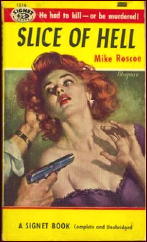





 Consigned to Death, Cleland’s debut for antiques dealer Josie Prescott.
Consigned to Death, Cleland’s debut for antiques dealer Josie Prescott.